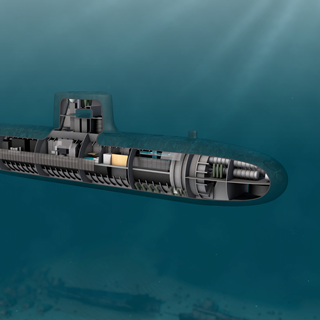
A vision for science and innovation in the context of delivering against maritime 2050
The potential opportunities and rewards are vast. Let’s change where we need to, let’s collaborate more. We will not just survive, but thrive!
7 March 2019
BMT’s Chief Executive Sarah Kenny delivered this key note speech at The Foundation of Science and Technology on 6 March 2019.
***
Ladies and Gentlemen, I am delighted to be here this evening, and I would like to thank the Foundation for asking me to speak, on a subject that is very close to my heart.
As you have heard/seen from my biography/introduction, aside from my ‘day job’ as the Chief Executive of BMT Group, in December last year I took up the position of Vice Chair of Maritime UK. In this new role, I have learnt much about the broader activities of our sector, and I have to say I am excited by what I see. For a sector who collectively contribute over £40bn to the UK economy, and employ in the order of one million people, and with 95% of UK trade conducted by the sea, I believe we are a sector whose contribution has not been well understood and I see this as a huge opportunity.
I am especially pleased that the UK is taking a leading role in maritime science, technology, and innovation.
This leadership is in many ways encapsulated in the UK Governments ‘Maritime 2050’ report, which was launched in January this year. I encourage you all to engage with the report, which charts the UK’s course to maritime growth. It has a necessary major focus on how we will achieve and sustain competitive advantage through smart exploitation of technology, human capital, and most importantly how we accelerate progress and improve our chances of success through partnership between Government and Industry. As an island nation with a long seafaring tradition, Britain has a rich maritime heritage, with particularly impressive achievements in technology and innovation, such as the first iron-clad warships, steam ships, hovercraft, and hydrofoils. And on the topic of innovation, this is often conflated with technology, but it is of course much broader. For example, the UK has an excellent reputation in the development of safe maritime operations. Our historic and ongoing influence is evident in maritime regulation worldwide today, such as the load-line to indicate the safe loading level for ships, created by British MP Samuel Plimsoll in the mid 19th Century, and our model for the Marine Accident Investigation Branch, established during the 1980’s, which has been adopted in many other countries since. Additionally, our approach to the optimal employment and training of people at sea is evident across the world – a notable example being in the way that the Royal Navy’s command and branch structures, and training techniques, can be observed in many other navies.
The maritime sector is, and always has been, international by design. As such, we are influenced by geopolitical events and trends, and we have historically anticipated and responded well to these with our approach to commerce and our business models. However, it is fair to say that the rate of change is increasing.
Drawing these threads together, and bringing them up to date Today, we are seeing the impact of dynamic and rapidly changing trade policies, through interventions such as BREXIT, America First, and Chinese Belt and Road. This environment drives uncertainty, but that is not a place that we can afford to dwell in – we have to respond and adapt - through improved investment, innovation and collaboration. This can only be truly enabled by business leaders adapting mindsets towards more flexible, agile, business models, in consort with Governmental and other stakeholders.
To highlight this, in its Report – ‘The Ocean Economy in 2030’, the Organisation for Economic Co-operation and Development, or OECD, predict that the Maritime Industry is poised to undergo a profound transition. The OECD estimates that the Ocean Industries can double their contribution to Global Value Creation by 2030. They, like many analysts and commentators anticipate that the future will see an increased demand for shipping, shipbuilding, marine equipment, and related services. So, the opportunity is both exciting and compelling. However, the investment into advanced technology, its adoption and integration, coupled to a forward-leaning approach to how we best employ our workforce, and to the flexible collaborative business models we need, supported by government, will be essential in order to take full advantage of this compelling future and not to be subjected to strategic shocks from non-traditional players.
I have highlighted already that the maritime sector faces a period of profound change. We should expect to see new geo-political imperatives, feel the impact of potentially disruptive advanced technologies, respond to the changing nature of trade, and trade relationships between nations, plan for demographic and social changes and develop new business models. This future is sometimes referred to as the Fourth Industrial Revolution and in many ways, I believe the maritime sector is ill prepared for the disruption which is unfolding.
Let’s speculate for a moment about just how our maritime world will look in this new advanced technology future. We will see Smart ships, exploiting advanced navigation and communications technologies, with on-board sensors and intelligent systems, using lightly manned semi-autonomous, and in time, un-manned and fully autonomous capabilities. They will operate seamlessly with digital, inter-connected ports, which use digitally tagged containers, autonomous trucks and remotely operated cranes to drive up efficiency and productivity. Logistics and asset data from many and disparate sources is handled using technologies such as block chain to quickly, securely, and accurately, connect owners, operators, hauliers, traders, insurers, supply chains, and consumers, with real time information about their products or assets.
Fully realised, these technologies will create an innovative, connected, trading ecosystem, transforming our maritime sector from where it is today. For example, greatly enhanced speed and productivity of shipping and port operations could credibly drive a change to the types and volumes of goods and services which are traded internationally by sea…whist the adoption of technology-enabled security enhancements will increasingly influence customer and supply-chain choice as to where trade takes place, in a world where cyber and piracy threats may also disrupt established trade routes and practices.
I am sure that for many of you in the audience, you can envisage this future, but if anyone thinks it sounds infeasible, many of the things I have just mentioned are already being trialed or are being actively exploited today. Advanced technology will transform maritime operations. AND, instead of using technology solely to drive cost efficiencies, which is often a euphemism for reducing the number of people employed, there is actually an opportunity to gain a strategic edge through the well-considered integration of people and technology, taking people out of the loop where safety and drudgery can be overcome by technology, and instead delivering role-augmentation and human-system partnerships so that we can enhance performance and productivity. This will need highly-trained, motivated and committed personnel or we simply will not achieve competitive edge. In the war for talent, we must therefore ‘up’ the image of our sector so that we don’t miss the boat..
Maritime 2050
Looking in more detail at Maritime 2050, it contains a wealth of recommendations and provides the UK with a real opportunity to take advantage of these changes, and to be recognised as a leading innovator in maritime science and technology. The Government has estimated the value of the global Ocean Economy to be $3trn by 2030. Much of the growth will come from the exploitation of the maritime environment in new and exciting ways, such as advanced aqua-culture and seabed mining.
Maritime 2050 commits the UK to charting its own seabed and then going beyond. On its own, charting the seabed may not seem like an obvious thing to do – but it is the opportunity that the knowledge generated can unlock that is important. Ed will talk more about this I am sure but I believe that this uncharted frontier offers great potential for British industry, and will necessitate ever closer collaboration and knowledge sharing between industry, government, and academia.
On autonomy and digitisation, the UK is already a leader in the design and manufacture of small autonomous vessels, and autonomous command and control, with particular specialism clustered around the south coast. Through Maritime 2050, government and industry will deliver flagship projects to develop technological proofs of concept, and provide demonstration-of-use cases for smart shipping. We are leading the debate on the regulation of autonomy. Maritime 2050 recommends that Government lead efforts to establish a new, proactive and adaptive, international regulatory framework for autonomous vessels at the IMO. This builds upon the work of the Maritime UK Autonomous Systems Regulatory Working Group, which hosted its international conference earlier this year.
And finally, Maritime 2050 will see government and industry working together to achieve the first multi-modal autonomous freight movement through a UK port. Realising the potential of digitised ports and shipping. On low-carbon technology, the IMO has set our global sector a massive, progressive challenge - To reduce carbon emissions by 50% by 2050. To meet this challenge shipowners, manufacturers, service providers, technologists and universities must innovate and collaborate. The Industrial Strategy’s Clean Growth focus could offer the opportunity to support such collaborative efforts. We will need to innovate in vessel efficiency, propulsion, and energy management, and draw upon capabilities from other sectors and new ideas - many of which may come from SME’s.
Maritime Research and Innovation UK
So how do we as an enterprise deliver against the vision? For the last few years a significant level of effort has been expended by industry and academia, supported by Government, to establish A Maritime Research and Innovation hub, MarRI-UK. MarRI-UK is an open consortium, aimed at creating something bigger than the sum of the parts, by pooling collective investment in maritime sector innovation. The founding members are BAE, BMT, Babcock, Rolls Royce, Shell, QinetiQ and Lloyds Register, together with universities of Newcastle, Southampton, Strathclyde & UCL, and the SMI. The core group of MarRI-UK companies and universities have been working to generate national scale funding and support. We are conscious that until now we have not been able to reach out as widely as we would have liked - until we felt confident of gaining pan-industry, academia and Government support. With the publication of Maritime 2050, we now have the confidence to start reaching out to a wider group of potential partners and this is beginning now.
We are looking for a range of partners in maritime research and innovation to join. We aim to create in MarRI-UK both a large enough critical mass and regional spread, that we can collectively prioritise resource for the maritime sector to achieve the 2050 vision. It’s focus will be on mid-Technology Readiness Level Innovations, that address the ‘valley of opportunity’ between ‘discovery and research’ and ‘commercialisation’. It will provide much needed co-ordination and collaboration across our diverse industry. But it’s not about bricks and mortar - there is no new building. MarRI-UK will be a hybrid physical and virtual collaboration environment, encompassing a range of centres which already exist, with a small core team in Glasgow to develop a prescriptive research and innovation programme driven by industry needs. It will focus on key drivers: Business growth, Safety and Environmental Regulation and Cost reduction.
I urge government and industry colleagues to view the creation of MarRI-UK - the first truly national cross-sector vehicle for collaborative maritime research innovation - as a key delivery engine for many of the technology recommendations within Maritime 2050. To make this work for all our benefit, and to fully realise the benefits of the technological opportunities within Maritime 2050, We must build a culture of collaboration within our sector - one that does not necessarily have a long tradition of such collaboration. So that requires change. We have made real progress on this, but there is more to do. In conclusion, Maritime 2050 is a plan, with real cross-government buy-in, to direct our efforts for our future.
I have set out my views on the possible futures for the Marine and Maritime Industries, based upon innovation, the adoption, and integration, or otherwise, of emergent advanced technologies, and how they, alongside future workforce dynamics, and other sociological and geopolitical trends, could shape our maritime future. I have summarised the industry response to Maritime 2050 - MarRI-UK and urged greater collaboration and co-operation across the sector. In close, I’ll add that Darwin said that “It is not the strongest of the species that survives, nor the most intelligent that survives. It is the one that is the most adaptable to change.”
Ladies and Gentlemen, the future is incredibly exciting. The potential opportunities and rewards are vast.
Let’s change where we need to, let’s collaborate more. We will not just survive, but thrive!

Sarah Kenny is the Chief Executive for BMT; a leading international scientific and engineering technical services and consulting business, with deep specialism in defence and security, specialist ship design and surveys, critical infrastructure, and environmental modelling. A marine environmental scientist by background, Sarah has worked in marine and maritime science and technology businesses throughout her career.
Sarah is Chair of Maritime UK, a board member of Maritime London, and a Trustee Director of the National Oceanography Centre. She is also a member of the UK Defence Innovation External Advisory Panel, and the UK Maritime Enterprise Working Group.
Sarah is very proud to be an Honorary Captain of the Royal Navy, and an Honorary member of the Royal Corps of Naval Constructors. Passionate about sustainment of the UK engineering, science and technology skills base, Sarah commits time to STEM projects in the Maritime field.
Sarah was awarded an OBE in the 2019 Queen’s Birthday Honours list, for her services to the Maritime Industry and Diversity. In the same year, Sarah was delighted to be awarded an Honorary doctorate from the University of Portsmouth.

N/A
More and more organisations are maturing their Asset Management approaches by applying ISO 55000 principles and recognised good practice to reach their long-term strategic outcomes or goals. In this context, BMT’s Stephen Hodson and Ewan Glen provide insight into four key strategic enablers to meeting the Greening Government Commitments for 2025 and the ambitious 2050 target for carbon neutrality (Net Zero).

N/A
Submarines are designed for a service life of more than 25 years. Therefore, they need to be prepared to meet the needs of tomorrow's and today's needs, which means a flexible operational capability and increased importance on areas such as sustainability and climate resilience in design.

Chris Shearer
There is an increasing global need to transition from fossil fuels to renewable energy, which, combined with a demand for increased aquaculture production, means there is massive potential to do more in the blue economy sector.

N/A
Whilst numerous digital transformation programmes successfully deliver technological change, persuading stakeholders to embrace and fully exploit the new tools and functionality they will have at their disposal can be an uphill battle.